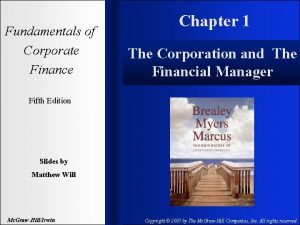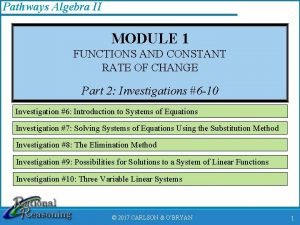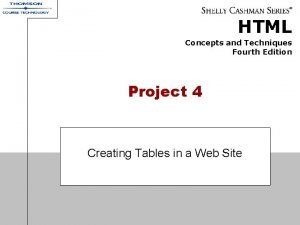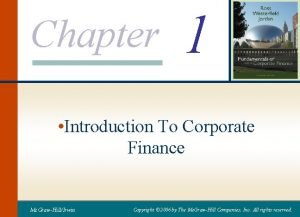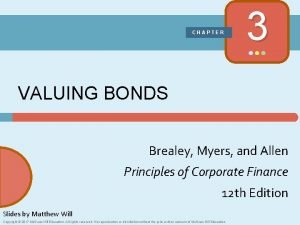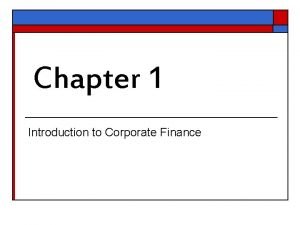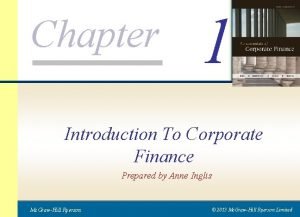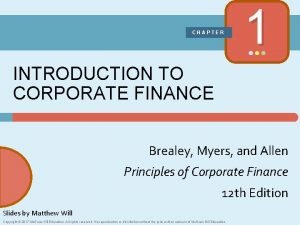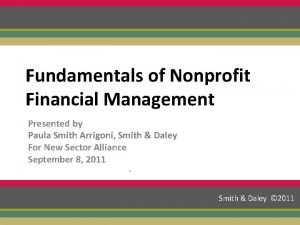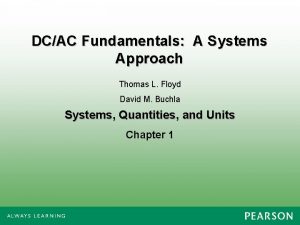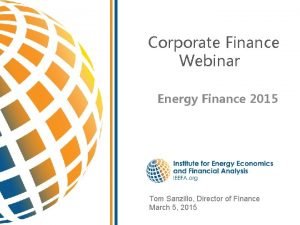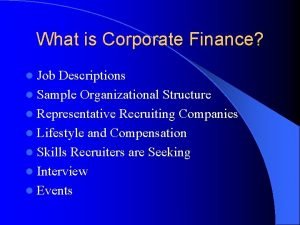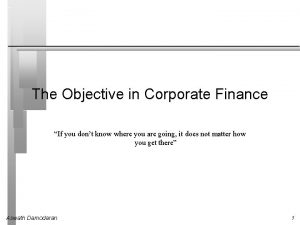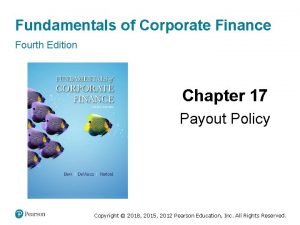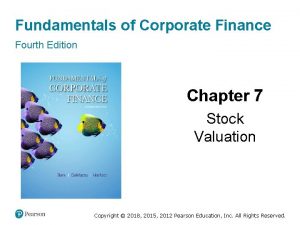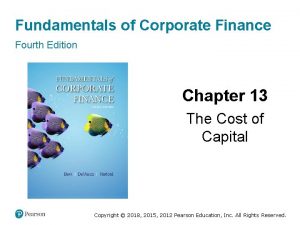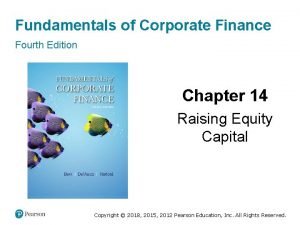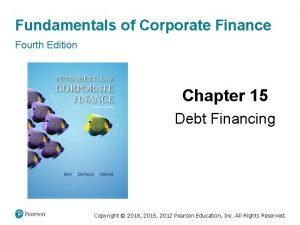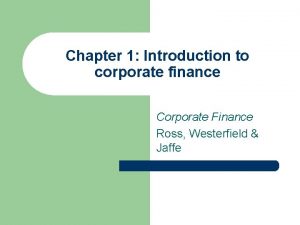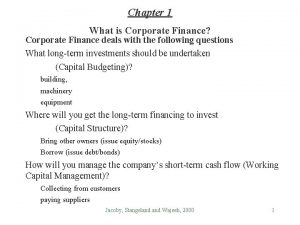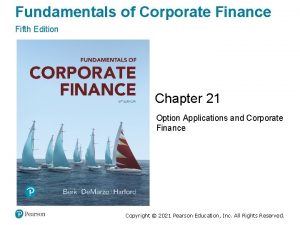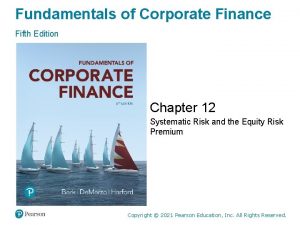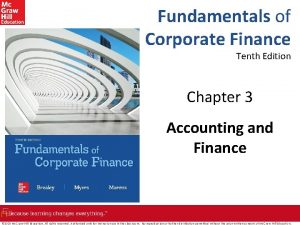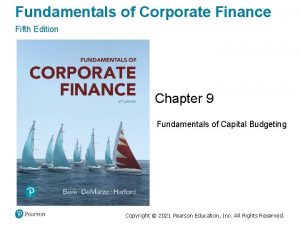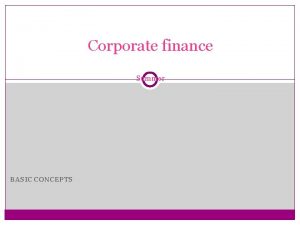Fundamentals of Corporate Finance Fourth Edition Chapter 4
















































- Slides: 48

Fundamentals of Corporate Finance Fourth Edition Chapter 4 Time Value of Money: Valuing Cash Flow Streams Copyright © 2018, 2015, 2012 Pearson Education, Inc. All Rights Reserved.

4. 1 Valuing a Stream of Cash Flows (1 of 11) • Rules developed in Chapter 3: – Rule 1: Only values at the same point in time can be compared or combined. – Rule 2: To calculate a cash flow’s future value, we must compound it. – Rule 3: To calculate the present value of a future cash flow, we must discount it. Copyright © 2018, 2015, 2012 Pearson Education, Inc. All Rights Reserved.

4. 1 Valuing a Stream of Cash Flows (2 of 11) Applying the Rules of Valuing Cash Flows • Suppose we plan to save $1, 000 today, and $1, 000 at the end of each of the next two years • If we earn a fixed 10% interest rate on our savings, how much will we have three years from today? Copyright © 2018, 2015, 2012 Pearson Education, Inc. All Rights Reserved.

4. 1 Valuing a Stream of Cash Flows (5 of 11) • Another approach is to compute the future value in year 3 of each cash flow separately • Once all amounts are in year 3 dollars, combine them Copyright © 2018, 2015, 2012 Pearson Education, Inc. All Rights Reserved.

4. 1 Valuing a Stream of Cash Flows (8 of 11) Using a Financial Calculator: Solving for Present and Future Values of Cash Flow Streams • Financial calculators and spreadsheets have the formulas preprogrammed to quicken the process • There are five variables used most often: – – – N = Number of periods PV = Present value PMT = Payment FV = Future value I/Y = Interest rate • Each function takes four variables as inputs and returns the value of the fifth Copyright © 2018, 2015, 2012 Pearson Education, Inc. All Rights Reserved.

4. 1 Valuing a Stream of Cash Flows (9 of 11) Example 1: • Suppose you plan to invest $20, 000 in an account paying 8% interest. • How much will you have in the account in 15 years? • To compute the solution, we enter the four variables we know and solve for the one we want to determine, FV. Copyright © 2018, 2015, 2012 Pearson Education, Inc. All Rights Reserved.

4. 1 Valuing a Stream of Cash Flows (10 of 11) Example 1: • For the HP-10 BII or the TI-BAII Plus calculators: – – – Enter 15 and press the N key. Enter 8 and press the I/Y key (I/YR for the HP) Enter − 20, 000 and press the PV key. Enter 0 and press the PMT key. Press the FV key (for the TI, press “CPT” and then “FV”). Copyright © 2018, 2015, 2012 Pearson Education, Inc. All Rights Reserved.

4. 1 Valuing a Stream of Cash Flows (11 of 11) Excel Formula: = FV(0. 08, 15, 0, -20000) • Notice that PV (the amount we’re putting in to the bank)is entered as a negative number and FV (the amount we take out of the bank)is shown as a positive number. • It is important to enter the signs correctly to indicate the direction the cash flows are moving. It is also important to note that an interest rate of 8% is entered as “ 8” in a financial calculator, but as “ 0. 08” in Excel. Copyright © 2018, 2015, 2012 Pearson Education, Inc. All Rights Reserved.

4. 2 Perpetuities (1 of 7) • The formulas we have developed so far allow us to compute the present or future value of any cash flow stream • Now we will consider two types of cash flow streams: – Perpetuities – Annuities Copyright © 2018, 2015, 2012 Pearson Education, Inc. All Rights Reserved.

4. 2 Perpetuities (2 of 7) Perpetuities – A perpetuity is a stream of equal cash flows that occur at regular intervals and last forever – Here is the timeline for a perpetuity: – the first cash flow does not occur immediately; it arrives at the end of the first period Copyright © 2018, 2015, 2012 Pearson Education, Inc. All Rights Reserved.

4. 2 Perpetuities (3 of 7) • Using the formula for present value, the present value of a perpetuity with payment C and interest rate r is given by: • Notice that all the cash flows are the same • Also, the first cash flow starts at time 1 (there is no cash flow at time 0) Copyright © 2018, 2015, 2012 Pearson Education, Inc. All Rights Reserved.

4. 2 Perpetuities (7 of 7) Present Value of a Perpetuity Copyright © 2018, 2015, 2012 Pearson Education, Inc. All Rights Reserved.

Example 4. 3 a Endowing a Perpetuity (1 of 4) Problem: • You just won the lottery, and you want to endow a professorship at your alma mater. • You are willing to donate $4 million of your winnings for this purpose. • If the university earns 5% per year on its investments, and the professor will be receiving her first payment in one year, how much will the endowment pay her each year? Copyright © 2018, 2015, 2012 Pearson Education, Inc. All Rights Reserved.

Example 4. 3 a Endowing a Perpetuity (2 of 4) Solution: Plan: • The timeline of the cash flows you want to provide is: • This is a standard perpetuity. The amount she can withdraw each year and keep the principal intact is the cash flow when solving equation 4. 4. Copyright © 2018, 2015, 2012 Pearson Education, Inc. All Rights Reserved.

Example 4. 3 a Endowing a Perpetuity (3 of 4) Execute: • From the formula for a perpetuity, Copyright © 2018, 2015, 2012 Pearson Education, Inc. All Rights Reserved.

Example 4. 3 a Endowing a Perpetuity (4 of 4) Evaluate: • If you donate $4, 000 today, and if the university invests it at 5% per year forever, then the chosen professor will receive $200, 000 every year. Copyright © 2018, 2015, 2012 Pearson Education, Inc. All Rights Reserved.

4. 3 Annuities (1 of 8) • Annuities – An annuity is a stream consisting of a fixed number of equal cash flows paid at regular interval – The difference between an annuity and a perpetuity is that an annuity ends after some fixed number of payments Copyright © 2018, 2015, 2012 Pearson Education, Inc. All Rights Reserved.

4. 3 Annuities (7 of 8) In general: Copyright © 2018, 2015, 2012 Pearson Education, Inc. All Rights Reserved.

Example 4. 4 Present Value of a Lottery Prize Annuity (1 of 7) Problem • You are the lucky winner of a $30 million state lottery. You can take your prize money either as (a) 30 payments of $1 million per year (starting today), or (b) $15 million paid today. If the interest rate is 8%, which option should you choose? Copyright © 2018, 2015, 2012 Pearson Education, Inc. All Rights Reserved.

Example 4. 4 Present Value of a Lottery Prize Annuity (2 of 7) Solution Plan • Option (a) provides $30 million in prize money but paid over time. To evaluate it correctly, we must convert it to a present value. Here is the timeline: Copyright © 2018, 2015, 2012 Pearson Education, Inc. All Rights Reserved.

Example 4. 4 Present Value of a Lottery Prize Annuity (3 of 7) • Because the first payment starts today, the last payment will occur in 29 years (for a total of 30 payments). The $1 million at date 0 is already stated in present value terms, but we need to compute the present value of the remaining payments. Fortunately, this case looks like a 29 -year annuity of $1 million per year, so we can use the annuity formula. Copyright © 2018, 2015, 2012 Pearson Education, Inc. All Rights Reserved.

Example 4. 4 Present Value of a Lottery Prize Annuity (4 of 7) Execute • We use the annuity formula: • Thus, the total present value of the cash flows is $1 million + $11. 16 million = $12. 16 million. In timeline form: Copyright © 2018, 2015, 2012 Pearson Education, Inc. All Rights Reserved.

Example 4. 4 Present Value of a Lottery Prize Annuity (5 of 7) • Option (b), $15 million upfront, is more valuable—even though the total amount of money paid is half that of option (a). Financial calculators or Excel can handle annuities easily—just enter the cash flow in the annuity as the PMT: Copyright © 2018, 2015, 2012 Pearson Education, Inc. All Rights Reserved.

Example 4. 4 Present Value of a Lottery Prize Annuity (6 of 7) Excel Formula: PV(RATE, NPER, PMT, FV)PV(0. 08, 29, 1000000, 0) • Both the financial calculator and Excel will give you the PV of the 29 payments ($11, 158, 406, or 11. 16 million), to which you must add the first payment of $1 million just as shown. Copyright © 2018, 2015, 2012 Pearson Education, Inc. All Rights Reserved.

Example 4. 4 Present Value of a Lottery Prize Annuity (7 of 7) Evaluate • The reason for the difference is the time value of money. If you have the $15 million today, you can use $1 million immediately and invest the remaining $14 million at an 8% interest rate. This strategy will give you $14 million × 8% = $1. 12 million per year in perpetuity! Alternatively, you can spend $15 million −$11. 16 million = $3. 84 million today, and invest the remaining $11. 16 million, which will still allow you to withdraw $1 million each year for the next 29 years before your account is depleted. Copyright © 2018, 2015, 2012 Pearson Education, Inc. All Rights Reserved.

4. 3 Annuities (8 of 8) Future Value of an Annuity Copyright © 2018, 2015, 2012 Pearson Education, Inc. All Rights Reserved.

4. 4 Growing Cash Flows (1 of 5) • A growing perpetuity is a stream of cash flows that occur at regular intervals and grow at a constant rate forever • For example, a growing perpetuity with a first payment of $100 that grows at a rate of 3% has the following timeline: Copyright © 2018, 2015, 2012 Pearson Education, Inc. All Rights Reserved.

4. 4 Growing Cash Flows (2 of 5) Present Value of a Growing Perpetuity Copyright © 2018, 2015, 2012 Pearson Education, Inc. All Rights Reserved.

4. 5 Solving for Variables Other Than Present Value or Future Value (1 of 10) • In some situations, we use the present and/or future values as inputs, and solve for the variable we are interested in. • We examine several special cases in this section. Copyright © 2018, 2015, 2012 Pearson Education, Inc. All Rights Reserved.

4. 5 Solving for Variables Other Than Present Value or Future Value (2 of 10) Solving for Cash Flows in an Annuity (Loan Payment) Copyright © 2018, 2015, 2012 Pearson Education, Inc. All Rights Reserved.

Example 4. 8 Computing a Loan Payment (1 of 4) Problem • Your firm plans to buy a warehouse for $100, 000. The bank offers you a 30 -year loan with equal annual payments and an interest rate of 8% per year. The bank requires that your firm pays 20% of the purchase price as a down payment, so you can borrow only $80, 000. What is the annual loan payment? Copyright © 2018, 2015, 2012 Pearson Education, Inc. All Rights Reserved.

Example 4. 8 Computing a Loan Payment (2 of 4) Solution Plan • We start with the timeline (from the bank’s perspective): Using Eq. 4. 9, we can solve for the loan payment, C, given N = 30, r = 0. 08, and P = $80, 000. Copyright © 2018, 2015, 2012 Pearson Education, Inc. All Rights Reserved.

Example 4. 8 Computing a Loan Payment (3 of 4) Execute • Equation 4. 9 gives the following payment (cash flow): Using a financial calculator or Excel: Copyright © 2018, 2015, 2012 Pearson Education, Inc. All Rights Reserved.

Example 4. 8 Computing a Loan Payment (4 of 4) Excel Formula: PMT(RATE, NPER, PV, FV)PMT(0. 08, 30, − 80000, 0) Evaluate • Your firm will need to pay $7106. 19 each year to repay the loan. The bank is willing to accept these payments because the PV of 30 annual payments of $7106. 19 at 8% interest rate per year is exactly equal to the $80, 000 it is giving you today. Copyright © 2018, 2015, 2012 Pearson Education, Inc. All Rights Reserved.

4. 5 Solving for Variables Other Than Present Value or Future Value (3 of 10) • Rate of Return – The rate of return is the rate at which the present value of the benefits exactly offsets the cost Copyright © 2018, 2015, 2012 Pearson Education, Inc. All Rights Reserved.

4. 5 Solving for Variables Other Than Present Value or Future Value (4 of 10) • Suppose you have an investment opportunity that requires a $1000 investment today and will pay $2000 in six years • What interest rate, r, would you need so that the present value of what you get is exactly equal to the present value of what you give up? Copyright © 2018, 2015, 2012 Pearson Education, Inc. All Rights Reserved.

4. 5 Solving for Variables Other Than Present Value or Future Value (5 of 10) • Rearranging: Copyright © 2018, 2015, 2012 Pearson Education, Inc. All Rights Reserved.

4. 5 Solving for Variables Other Than Present Value or Future Value (6 of 10) • Suppose your firm needs to purchase a new forklift • The dealer gives you two options: 1. A price for the forklift if you pay cash ($40, 000) 2. The annual payments if you take out a loan from the dealer (no money down and four annual payments of $15, 000) Copyright © 2018, 2015, 2012 Pearson Education, Inc. All Rights Reserved.

4. 5 Solving for Variables Other Than Present Value or Future Value (7 of 10) • Setting the present value of the cash flows equal to zero requires that the present value of the payments equals the purchase price: • The solution for r is the interest rate charged by the dealer, which you can compare to the rate charged by your bank Copyright © 2018, 2015, 2012 Pearson Education, Inc. All Rights Reserved.

4. 5 Solving for Variables Other Than Present Value or Future Value (8 of 10) • There is no simple way to solve for the interest rate • The only way to solve this equation is to guess at values for r until you find the right one • An easier solution is to use a financial calculator or a spreadsheet Copyright © 2018, 2015, 2012 Pearson Education, Inc. All Rights Reserved.

4. 5 Solving for Variables Other Than Present Value or Future Value (9 of 10) Excel Formula: =RATE(NPER, PMT, PV, FV)=Rate(4, -15000, 40000, 0) Copyright © 2018, 2015, 2012 Pearson Education, Inc. All Rights Reserved.

4. 5 Solving for Variables Other Than Present Value or Future Value (10 of 10) • Solving for the Number of Periods – In addition to solving for cash flows or the interest rate, we can solve for the amount of time it will take a sum of money to grow to a known value – In this case, the interest rate, present value, and future value are all known – We need to compute how long it will take for the present value to grow to the future value Copyright © 2018, 2015, 2012 Pearson Education, Inc. All Rights Reserved.

Example 4. 10 Solving for the Number of Periods in a Savings Plan (1 of 6) Problem • Let’s return to your savings for a down payment on a house. Imagine that some time has passed and you have $10, 050 saved already, and you can now afford to save $5000 per year at the end of each year. Also, interest rates have increased so that you now earn 7. 25% per year on your savings. How long will it take to reach your goal of $60, 000? Copyright © 2018, 2015, 2012 Pearson Education, Inc. All Rights Reserved.

Example 4. 10 Solving for the Number of Periods in a Savings Plan (2 of 6) Solution Plan • The timeline for this problem is: Copyright © 2018, 2015, 2012 Pearson Education, Inc. All Rights Reserved.

Example 4. 10 Solving for the Number of Periods in a Savings Plan (3 of 6) • We need to find N so that the future value of your current savings plus the future value of your planned additional savings (which is an annuity) equals your desired amount. There are two contributors to the future value: the initial lump sum of $10, 050 that will continue to earn interest, and the annuity contributions of $5000 per year that will earn interest as they are contributed. Thus, we need to find the future value of the lump sum plus the future value of the annuity. Copyright © 2018, 2015, 2012 Pearson Education, Inc. All Rights Reserved.

Example 4. 10 Solving for the Number of Periods in a Savings Plan (4 of 6) Execute • We can solve this problem using a financial calculator or Excel: Excel Formula: NPER(RATE, PMT, PV, FV)NPER(0. 0725, − 5000, − 10050, 60000) Copyright © 2018, 2015, 2012 Pearson Education, Inc. All Rights Reserved.

Example 4. 10 Solving for the Number of Periods in a Savings Plan (5 of 6) • There is also a mathematical solution. We can calculate the future value of the initial cash flow by using Eq. 4. 1 and the future value of the annuity using Eq. 4. 6: Rearranging the equation to solve for N, we can then solve for N : Copyright © 2018, 2015, 2012 Pearson Education, Inc. All Rights Reserved.

Example 4. 10 Solving for the Number of Periods in a Savings Plan (6 of 6) Evaluate • It will take seven years to save the down payment. Copyright © 2018, 2015, 2012 Pearson Education, Inc. All Rights Reserved.
 Fundamentals of corporate finance, third canadian edition
Fundamentals of corporate finance, third canadian edition Fundamentals of corporate finance canadian edition
Fundamentals of corporate finance canadian edition Fundamentals of corporate finance fifth edition
Fundamentals of corporate finance fifth edition Fundamentals of corporate finance 6th edition
Fundamentals of corporate finance 6th edition Fundamentals of corporate finance chapter 6 solutions
Fundamentals of corporate finance chapter 6 solutions Fundamentals of corporate finance (doc or html) file
Fundamentals of corporate finance (doc or html) file Fundamentals of corporate finance, chapter 1
Fundamentals of corporate finance, chapter 1 Objectives of corporate governance
Objectives of corporate governance Corporate finance tenth edition
Corporate finance tenth edition Corporate finance tenth edition
Corporate finance tenth edition Corporate finance tenth edition
Corporate finance tenth edition Corporate finance tenth edition
Corporate finance tenth edition Corporate finance tenth edition
Corporate finance tenth edition Project 2 fourth edition
Project 2 fourth edition Algebra 2 module 1 answer key
Algebra 2 module 1 answer key Ethics in information technology fourth edition
Ethics in information technology fourth edition Ethics in information technology fourth edition
Ethics in information technology fourth edition Vertical line code in html
Vertical line code in html A computer programming team has 13 members
A computer programming team has 13 members Expert systems: principles and programming, fourth edition
Expert systems: principles and programming, fourth edition Introduction to corporate finance
Introduction to corporate finance Principles of corporate finance chapter 3 solutions
Principles of corporate finance chapter 3 solutions Corporate finance chapter 1
Corporate finance chapter 1 Chapter 1 introduction to corporate finance
Chapter 1 introduction to corporate finance Chapter 1 introduction to corporate finance
Chapter 1 introduction to corporate finance Finance fundamentals for nonprofits
Finance fundamentals for nonprofits Real estate finance fundamentals
Real estate finance fundamentals Fundamentals of information systems 9th edition
Fundamentals of information systems 9th edition Fundamentals of information systems 9th edition
Fundamentals of information systems 9th edition No slip condition
No slip condition Digital fundamentals 10th edition floyd
Digital fundamentals 10th edition floyd Machining fundamentals 10th edition
Machining fundamentals 10th edition Fundamentals of organizational communication 9th edition
Fundamentals of organizational communication 9th edition Fundamentals of organizational communication 9th edition
Fundamentals of organizational communication 9th edition Floyd digital fundamentals ppt
Floyd digital fundamentals ppt Floyd digital fundamentals 10th edition pdf
Floyd digital fundamentals 10th edition pdf Electronics fundamentals a systems approach
Electronics fundamentals a systems approach Computer security fundamentals 4th edition
Computer security fundamentals 4th edition Management fundamentals 8th edition
Management fundamentals 8th edition Fundamentals of information systems 9th edition
Fundamentals of information systems 9th edition Abnormal psychology comer 9th edition
Abnormal psychology comer 9th edition Fundamentals of information systems 9th edition
Fundamentals of information systems 9th edition Critical radius of insulation for cylinder
Critical radius of insulation for cylinder The fundamentals of political science research 2nd edition
The fundamentals of political science research 2nd edition Financial management theory
Financial management theory Tom sanzillo
Tom sanzillo Investment banking activities
Investment banking activities Corporate finance job scope
Corporate finance job scope Objective of corporate finance
Objective of corporate finance






